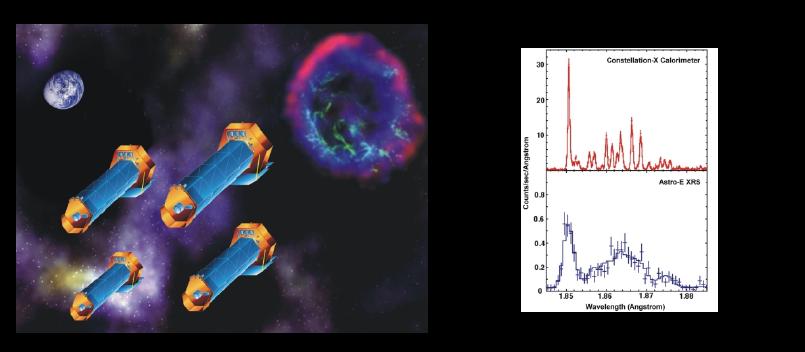
 Credit: Constellation-X team; NASA
Credit: Constellation-X team; NASA
Resolution for the Next Decade
Astronomy is, in large measure, a struggle to detect ever fainter objects
at high significance. This can be accomplished by building bigger
telescopes. But there are practical limits (mainly technological and
financial) which determine how large a telescope can be. So astronomers
have devised ways to allow many small (cheap) telescopes do the work of one
large (expensive) telescope. This technique has been in use by radio
astronomers for many years. It has recently been adapted for use by optical astronomers. Now
X-ray astronomers are getting into the act. The picture above represents a
next-generation X-ray telescope called Constellation-X.
Constellation-X will consist of four identical X-ray telescopes which will
operate jointly to provide the capability of one much larger X-ray
telescope. Constellation-X will be used by X-ray astronomers to produce
extremely high resolution X-ray spectra of faint objects in crowded fields.
The right side of the above image shows a simulation of an X-ray spectrum
obtained by Constellation-X, compared to a spectrum from the X-ray spectral
detectors on ASTRO-E (the instrument with the next-highest X-ray spectral
resolution). In the spectra a feature that appears as an unresolved "lump"
to ASTRO-E is cleanly resolved into individual emission lines by
Constellation-X. The higher spectral resolution provided by Constellation-X
will allow astronomers to measure accurately the motions of gas around
normal stars and near black holes. Constellation-X is currently expected
to launch in 2010.
Last Week *
HEA Dictionary * Archive
* Search HEAPOW
* Education
Each week the HEASARC
brings you new, exciting and beautiful images from X-ray and Gamma ray
astronomy. Check back each week and be sure to check out the HEAPOW archive!
Page Author: Dr. Michael F.
Corcoran
Last modified December 31, 2001


